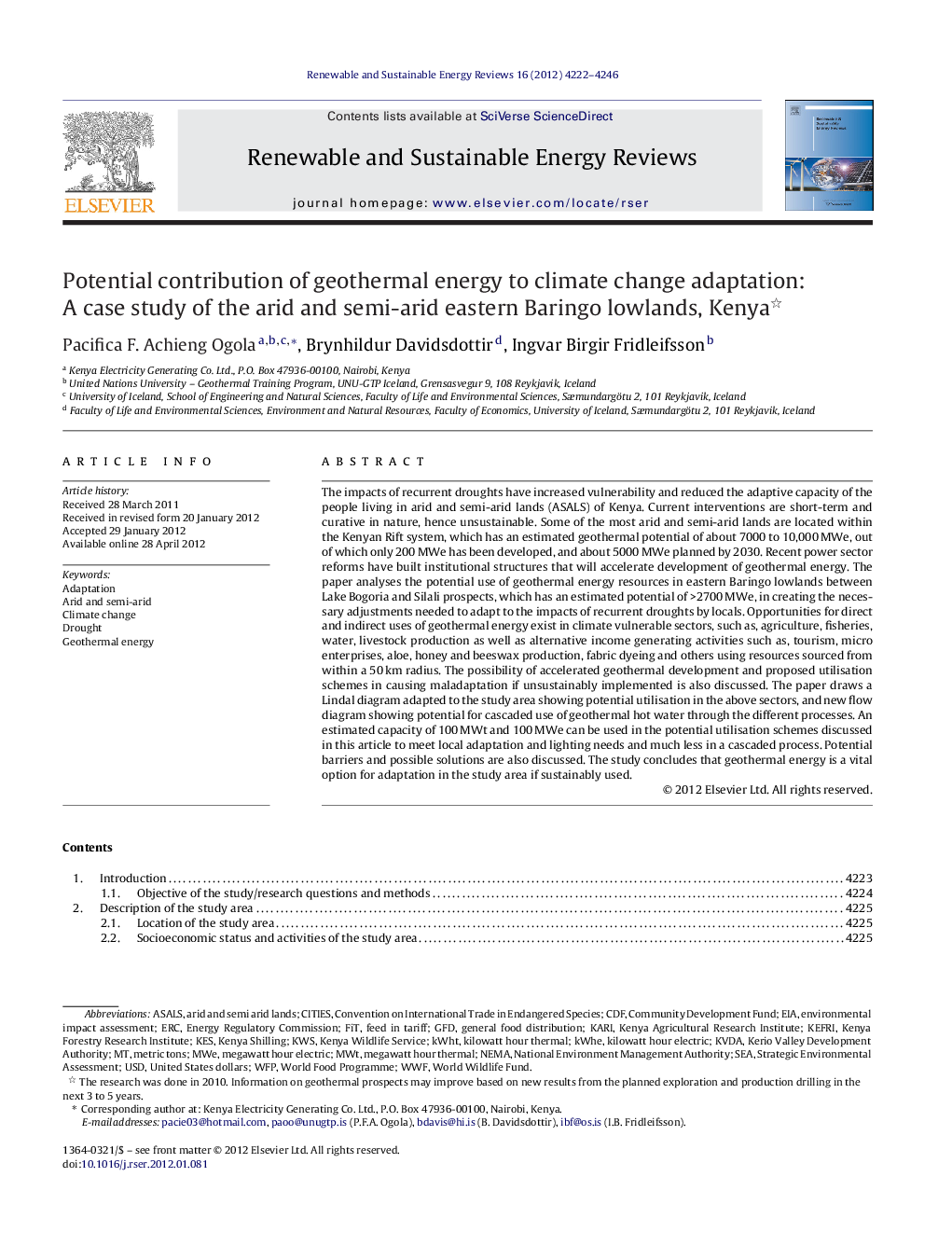| کد مقاله | کد نشریه | سال انتشار | مقاله انگلیسی | نسخه تمام متن |
|---|---|---|---|---|
| 10689913 | 1018402 | 2012 | 25 صفحه PDF | دانلود رایگان |
عنوان انگلیسی مقاله ISI
Potential contribution of geothermal energy to climate change adaptation: A case study of the arid and semi-arid eastern Baringo lowlands, Kenya
دانلود مقاله + سفارش ترجمه
دانلود مقاله ISI انگلیسی
رایگان برای ایرانیان
کلمات کلیدی
NEMAKESWorld Wildlife FundCDFWFPMWEERCMWTWWFGFDEnvironmental Impact Assessment - ارزیابی اثرات زیست محیطیStrategic environmental assessment - ارزیابی محیطی استراتژیکGeothermal energy - انرژی زمین گرماییEIA - اینClimate change - تغییرات آب و هواArid and semi-arid - خشک و نیمه خشکDrought - خشکسالیFeed in tariff - خوراک در تعرفهSea - دریاییUSD - دلار آمریکاUnited States dollars - دلار آمریکاAdaptation - سازگاری(زیست شناسی)Cities - شهرهاFIT - مناسبKARI - کاراییConvention on International Trade in Endangered Species - کنوانسیون تجارت بین المللی گونه های در معرض خطر
موضوعات مرتبط
مهندسی و علوم پایه
مهندسی انرژی
انرژی های تجدید پذیر، توسعه پایدار و محیط زیست
پیش نمایش صفحه اول مقاله

چکیده انگلیسی
The impacts of recurrent droughts have increased vulnerability and reduced the adaptive capacity of the people living in arid and semi-arid lands (ASALS) of Kenya. Current interventions are short-term and curative in nature, hence unsustainable. Some of the most arid and semi-arid lands are located within the Kenyan Rift system, which has an estimated geothermal potential of about 7000 to 10,000Â MWe, out of which only 200Â MWe has been developed, and about 5000Â MWe planned by 2030. Recent power sector reforms have built institutional structures that will accelerate development of geothermal energy. The paper analyses the potential use of geothermal energy resources in eastern Baringo lowlands between Lake Bogoria and Silali prospects, which has an estimated potential of >2700Â MWe, in creating the necessary adjustments needed to adapt to the impacts of recurrent droughts by locals. Opportunities for direct and indirect uses of geothermal energy exist in climate vulnerable sectors, such as, agriculture, fisheries, water, livestock production as well as alternative income generating activities such as, tourism, micro enterprises, aloe, honey and beeswax production, fabric dyeing and others using resources sourced from within a 50Â km radius. The possibility of accelerated geothermal development and proposed utilisation schemes in causing maladaptation if unsustainably implemented is also discussed. The paper draws a Lindal diagram adapted to the study area showing potential utilisation in the above sectors, and new flow diagram showing potential for cascaded use of geothermal hot water through the different processes. An estimated capacity of 100Â MWt and 100Â MWe can be used in the potential utilisation schemes discussed in this article to meet local adaptation and lighting needs and much less in a cascaded process. Potential barriers and possible solutions are also discussed. The study concludes that geothermal energy is a vital option for adaptation in the study area if sustainably used.
ناشر
Database: Elsevier - ScienceDirect (ساینس دایرکت)
Journal: Renewable and Sustainable Energy Reviews - Volume 16, Issue 6, August 2012, Pages 4222-4246
Journal: Renewable and Sustainable Energy Reviews - Volume 16, Issue 6, August 2012, Pages 4222-4246
نویسندگان
Pacifica F. Achieng Ogola, Brynhildur Davidsdottir, Ingvar Birgir Fridleifsson,